On our latest trip down the coast of East Africa, we had every intention of going directly from Tanzania to Mozambique using the Kalambo/Namoto crossing. But at the last minute we found out there was some fairly serious conflict going on just over the border, and we’d be heading straight into it. So we gave that a pass and figured we’d find another way to Mozambique. If there is one thing we’ve learned in our travels, it’s that there is always another option. Whether or not it’s a good option is beside the point.
So we were stuck in Mtwara, the last major town in Tanzania. Buses back to Dar es Salaam were sold out for days due to the Christmas holidays. Flights too. As for flying from Tanzania to Mozambique, well, that was prohibitively expensive and anyway, we wanted to go by road.
Looking at the map, it became clear to us that Lake Malawi (known in Tanzania as Lake Nyasa) was in our way. It straddles the borders of three countries and we envisioned ourselves skipping like two stones across the water, first into Malawi and then down to Mozambique. But when we finally found a ferry company and called for the schedule, in addition to offending the woman on the phone by referring to the lake with its Tanzanian name, we learned that no international passenger ferries (at all) were running at the moment.
Just as we started wondering if we should apply for permanent residency in Tanzania, Oyv looked at the map again, and said, ‘Fine. We’ll just go around Lake Nyasa. Lake Malawi. Whatever.’ And why not?…it’s only one of Africa’s Great Lakes, after all. We decided we’d take a break on the far side at Nkhata Bay, and eventually travel the rest of the way around to Mozambique.
Here’s how we did it:
The Route
Mtwara to Songea
Songea to Mbeya
Mbeya to Mzuzu (Malawi)
Mzuzu to Nkhata Bay
Onward Travel: Malawi to Mozambique
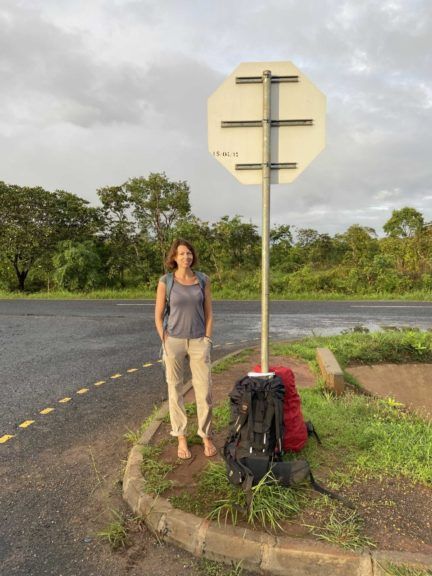
The route
From Mtwara you can get around the lake, into Malawi and reach Nkhata Bay in two to four days. Ideally it takes just two days, but we had two separate bus breakdowns which delayed us interminably, and you can’t rule those out. There was also just a lot of general disorder and waiting around, and you shouldn’t rule that sort of thing out either.
So, in this post I’ll outline each step as we took it, but if you magically avoid any delays and want to move faster, feel free to smush two days together where possible:
Day 1. From Mtwara, head inland – way inland, to Songea, a town described by our book as ‘exceedingly remote’. It’s a 12 hour trip and you’ll sleep in Songea that night.
Day 2. Go from Songea to Mbeya. It’s 7 or 8 hour trip and you can sleep in Mbeya that night.
Alternatively, it’s 4 to 5 hours from Mbeya to Karonga (in Malawi, including crossing) – so if you make it to Mbeya early in the afternoon, you can carry on and sleep in Karonga. In that case take a taxi from Mbeya right to the Tanzanian border, it’s much faster than the bus.
Day 3. If you slept in Karonga, you’re about 4 hours away from Mzuzu/Nkhata Bay and can get there before noon.
If you’re still in Mbeya, then get a really early start and travel to Karonga and on to Mzuzu – it will take about 8 hours. If possible, go straight from Mzuzu to Nkhata Bay. If you arrive late then you can sleep in Mzuzu.
Day 4. Hopefully, you’re already there. If not, you’ve got less than an hour to go, from Mzuzu to Nkhata Bay.
Besides being convoluted, this trip is also cheap. Including the long-haul buses, taxis and daladalas around towns, hotels and food, we spent less than 50 USD for two people each day.
If you’re doing something similar, here are a few other things to keep in mind: in Tanzania, scheduled buses generally depart on time – so show up early. In Malawi nothing seemed to leave on time. Big buses for long trips go early in the morning – after that, you’d be stuck with daladalas. I don’t think nightbuses run around this area – if they do I wouldn’t take one anyway. You get a reserved seat and luggage space with your ticket. The Tanzania-Malawi border crossing we used near Mwandenga, is open 24/7. Don’t plan on getting online much if you don’t have a local sim card, and bring the cash you need for a day or two in advance.
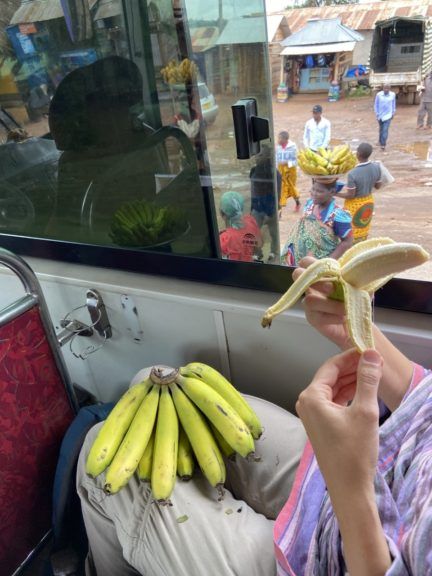
Mtwara to Songea
We went to the main bus station in Mtwara a day ahead. The bus company offices advertise their destinations. We booked tickets on Selous/Super Feo (they seem to be partners) from Mtwara to Songea, for the next day. We also reserved (but didn’t pay for) tickets with the same company from Songea to Mbeya for the day after that.
The big buses leave very early from Mkanarrdi, the station outside of town. It’s way too far to walk in the dark: arrange a taxi the night before. Get to the station at least half an hour early. Our bus left at 6.30 in the morning – just about on-time. Twelve hours later we got to Songea and picked up our reserved tickets to Mbeya at the station there. Then we took a taxi into town and stayed at Palpoki hotel which is comfortable, clean and pretty decent. We ate at Krista Palace: our taxi driver recommended it. He said, ‘That’s where all the guys like you eat’. We didn’t find WiFi in Songea (we didn’t look hard though). There are ATMs in town.
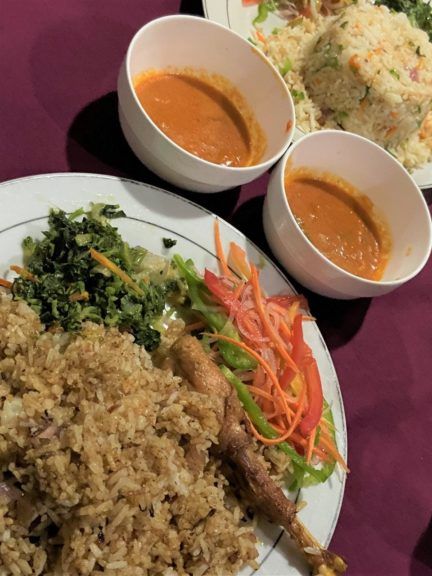
Something interesting: as you move inland – about halfway to Songea, to be precise – you can actually see Islam, the predominant religion on the coast, giving way to Christianity.
Songea to Mbeya
Organise your ride to the station in Songea the night before and arrive half an hour early. Our bus left at 6.30 am. It’s seven or eight hours to Mbeya, but in our case it took over twelve hours because the bus broke down and we waited around several hours on the side of the road for a replacement, which was too small and there was a LOT of fighting and screaming and pushing. If your bus breaks down it’s your problem, and not the bus company’s problem in any way. The big, dirty central station in Mbeya is full of aggressive horrible touts, and Mbeya in general has a reputation for thieves.
There are miserable hotels very near to the bus station. We walked a bit further to the slightly less miserable Mbeya Peak Hotel which is damp, deserted and musty but still better than sleeping next to the bus station. There’s a ‘restaurant’ there – you can ask the receptionist for food and then bargain for the meal and the price. Again, we didn’t find WiFi, but there are ATMs.
Mbeya to Mzuzu (Malawi)
Things usually look better in the daylight – even Mbeya. Still, you will want to leave. Don’t take a bus that supposedly goes all the way into Malawi – this is generally a lie. It seems the best way is to break it up into a couple of stages:
- Get a daladala to Nane Nane station – one goes right past the Mbeya Peak Hotel. Otherwise, get it at the bus station. It takes 40 minutes – lots faster if you just take a taxi.
- At Nane Nane the minibuses are signed. Find one going to Kyela and tell the conductor you’re going to Kasamulu (or the border). It takes two to three hours (just depends on luck, I think).
- At Kasamulu you get a bodaboda for 1000 TZS/no more than 50 cents USD – it’s a five minute ride to immigration.
The fastest way to do this would be to negotiate a taxi in Mbeya (or at Nane Nane) to take you straight to the border. Taxis don’t get hung up at all the police checks or stop every few metres to pick up more passengers, so it would take about half the time.
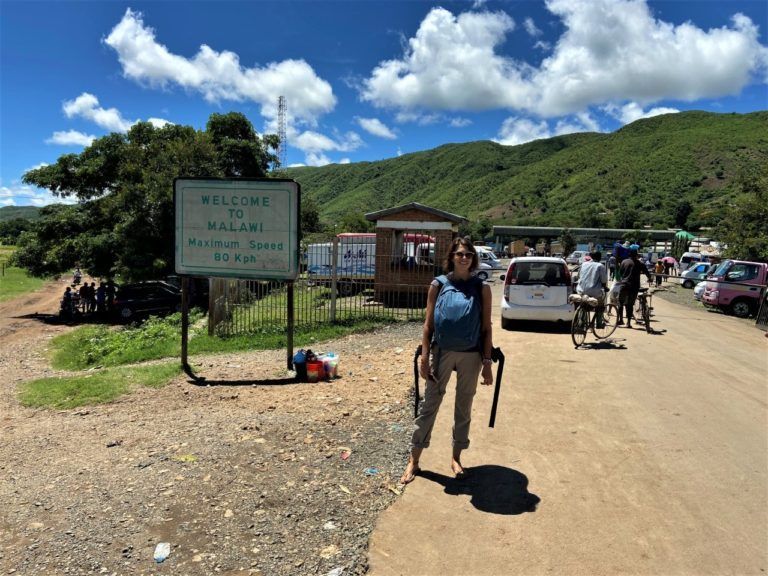
Get your visa on arrival at the Malawian side: it’s 75 USD. You can change TZS and USD to Kwacha on either side of the border, and there are ATMs in Kasamulu and Karonga.
After immigration, go out the gates and up some stairs, and in the street you’ll find cars/minibuses and a lot of touts. Get a share-taxi to Karonga, about an hour away. These are 5-6 passenger cars with front/middle/back seats and up to four people per row, including the front where three passengers share two seats with the driver.
At the main station in Karonga you’ll find the bus companies: Axa Bus runs to Mzuzu. Buy tickets from the office or from the guy with the big ledger in front of the bus. Departures are ‘scheduled’ but ours left an hour late. It’s about 3.5 hours to Mzuzu but our bus broke down (you bet it did) and caused an extra 3 hour delay.
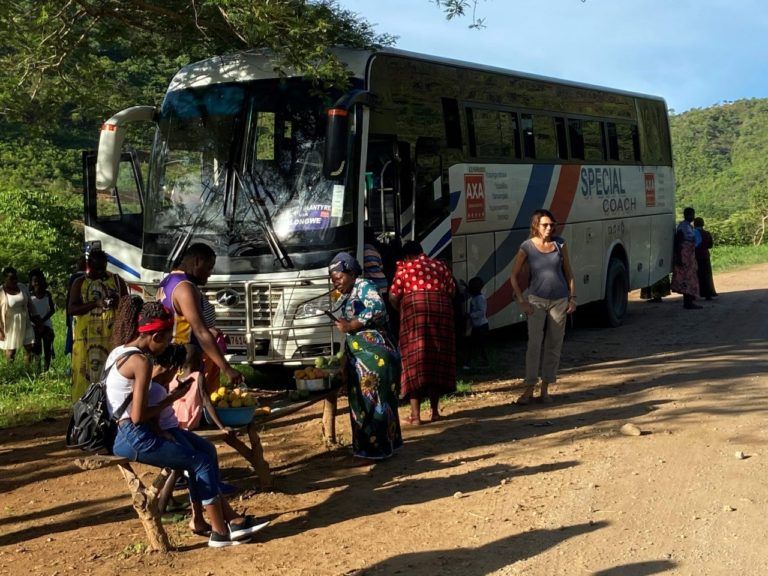
Depending on when you arrive in Mzuzu you can get a share-taxi or hire a taxi straight out to Nkhata Bay. We rolled into Mzuzu at 9 pm, totally wiped. I got off the bus, walked up to a light-skinned person (we hadn’t seen another white person in days), handed him my bag and started muttering about something…only to see that it wasn’t Oyv at all but a Lebanese guy who’d appeared in the street from nowhere. So we decided to just sleep in Mzuzu and move on in the morning.
Mzuzu to Nkhata Bay
Either go to the bus stand in Mzuzu, or just wait in the main road going towards Nkhata Bay to get a share-taxi. They run pretty frequently (during the day) to Nkhata Bay and take less than an hour. Once in Nkhata, you can easily find taxis, ATMs, food, supermarkets, accommodation, WiFi – whatever you want. We stayed at Myoka village, which has adorable cabins, fabulous lake views, and great food served on a big stilted deck over the lake. A free taxi will no doubt find you in town and take you there.
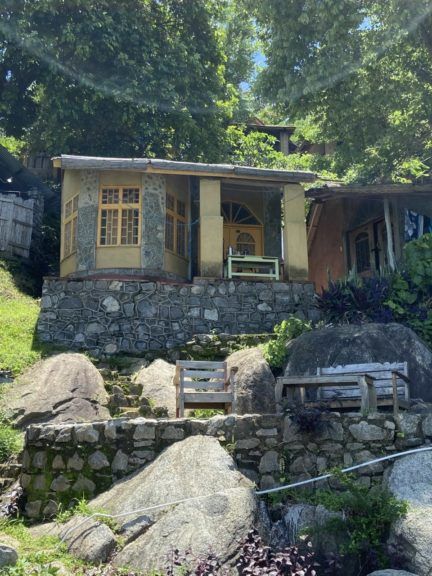
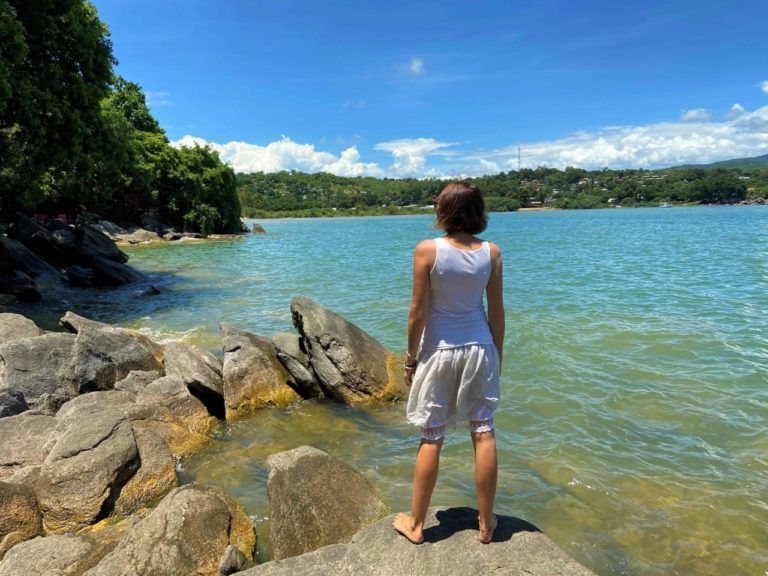
Onward travel: Malawi to Mozambique
After our break at the lake, we carried on from Malawi to Mozambique, another epic in itself. You can read about that here: How to Cross the Border from Malawi to Mozambique.
Read more
I also wrote a story about making our way from Tanzania to Malawi – Mafia Island and a Detour Around Lake Malawi: Christmas as Usual
For more about my adventures (and misadventures) in Tanzania or Malawi, you can check out my stories from the road. And, if you’re traveling along the east coast of Africa from Kenya, take a look at these posts:
Traveling the Kenyan Coast: Inspiration from North to South
How to Cross the Border from Kenya to Tanzania
Traveling the Tanzanian Coast: by Road from North to South



